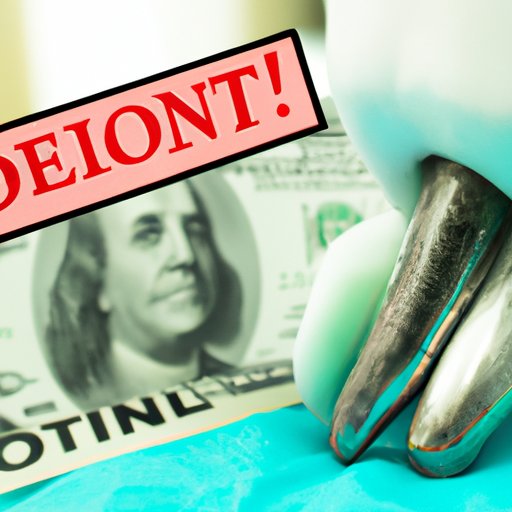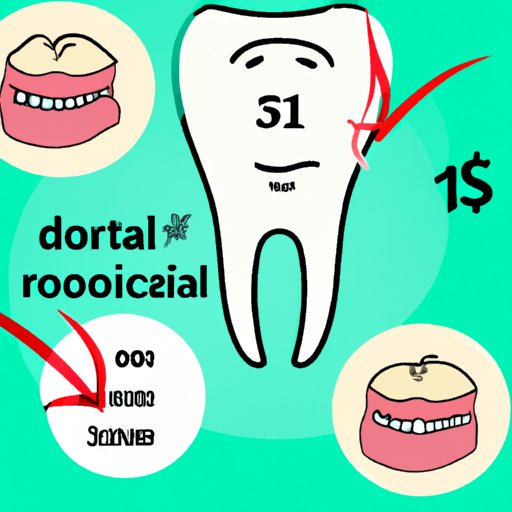Introduction
A root canal is a common dental procedure used to treat an infected or damaged tooth. The procedure involves removing the nerve, pulp, and bacteria from inside the tooth and then sealing it off. While root canals are typically recommended due to severe pain, they can also prevent further damage and infection.
The cost of a root canal varies depending on several factors, including location, type of procedure, and insurance coverage. On average, a root canal costs between $300 and $2,000, with most procedures falling in the range of $700 to $1,500.

A Comprehensive Guide to Root Canal Prices
When considering the cost of a root canal, there are several factors to take into account. The type of tooth being treated and the location of the dentist both play a role in determining the price. For example, a molar root canal may be more expensive than a front tooth root canal, and a root canal performed by a specialist may be more costly than one performed by a general dentist.
In addition to these factors, the complexity of the procedure will also have an impact on the cost. Generally speaking, the more complex the procedure, the higher the cost. For example, if multiple teeth are involved in the root canal, the cost may be higher than if only one tooth is treated.
Out-of-pocket expenses for root canals vary significantly, depending on the patient’s insurance coverage. Some insurance plans may cover all or part of the cost, while other plans may require the patient to pay the entire cost out of pocket.
How Does Insurance Affect the Cost of a Root Canal?
Insurance coverage for root canals varies depending on the type of plan and the specific policy. It’s important to understand your insurance coverage before undergoing any dental procedure. Most insurance plans will cover some portion of the root canal cost, although the amount covered may vary.
For example, some HMO plans may only cover a certain percentage of the total cost, while PPO plans may offer full or partial coverage. Additionally, some plans may require a deductible or copayment before they will cover the procedure. It’s important to check with your insurance provider to determine what type of coverage you have.
Understanding the Factors That Impact Root Canal Costs
In addition to insurance coverage, there are several other factors that can affect the cost of a root canal. The type of tooth being treated, the location of the dentist, and the length of the procedure are all important considerations. For example, treating a molar may be more expensive than treating a front tooth, and performing a root canal in an urban area may be more costly than in a rural area.
Additionally, the length of the procedure can have an impact on the cost. If the root canal requires more time or additional visits, the cost may increase. It’s important to speak with your dentist about the expected length of the procedure and any potential additional costs.

The Hidden Costs of Root Canals: What You Need to Know
In addition to the cost of the root canal itself, there may be additional fees associated with the procedure. These may include anesthesia costs, X-rays, and follow-up treatments. Anesthesia costs alone can range from $50 to $100, and X-rays may cost up to $100. Follow-up treatments may also be necessary, depending on the severity of the infection.
It’s important to consider all of these costs when budgeting for a root canal. Speak with your dentist beforehand to get a better understanding of the total cost of the procedure.
Conclusion
Root canals are a common dental procedure used to treat damaged or infected teeth. The cost of a root canal varies depending on several factors, including location, type of procedure, and insurance coverage. On average, a root canal costs between $300 and $2,000, with most procedures falling in the range of $700 to $1,500. Insurance coverage may help reduce the cost, but it’s important to understand the limits of your coverage before undergoing the procedure.
In addition to the cost of the root canal itself, there may be additional fees associated with the procedure. Anesthesia costs, X-rays, and follow-up treatments may all add to the total cost. It’s important to consider all of these costs when budgeting for a root canal.
To save money on a root canal, compare prices among local dentists and look for discounts or special offers. Additionally, ask your insurance provider about coverage options and look for ways to maximize your benefits. By taking the time to research and compare prices, you can find the best deal for your needs.
(Note: Is this article not meeting your expectations? Do you have knowledge or insights to share? Unlock new opportunities and expand your reach by joining our authors team. Click Registration to join us and share your expertise with our readers.)
